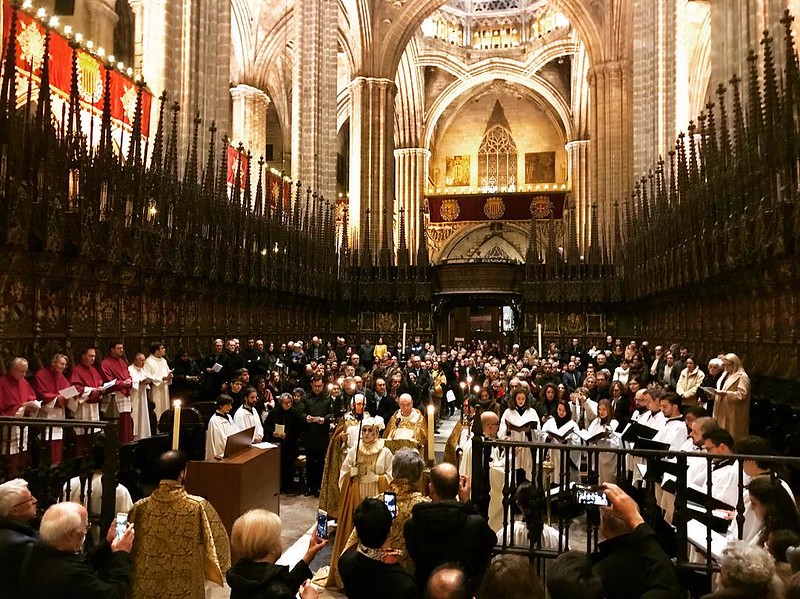Chant of the Sybil on Majorca
A Medieval Prophecy Echoes Through Majorcan Christmas
2025/12/23
As the clock strikes midnight on Christmas Eve, a haunting melody pierces the silence of Majorca's ancient churches.
The Chant of the Sybil, a UNESCO-recognized Intangible Cultural Heritage, transports listeners to a medieval world of prophecy and mysticism. The Sybil refers to a female prophetess from ancient Greek and Roman mythology.
This unique tradition, performed in churches across the island, offers visitors a rare glimpse into a living piece of European cultural history, blending solemn ritual with the warmth of Majorcan Christmas celebrations.
Main Attractions
The Chant: A Timeless Performance
At the heart of this tradition is the chant itself, a mesmerizing a cappella performance that echoes through the stone arches of Majorca's churches.
A young singer, often dressed in white or colorful robes, delivers the prophecy with a clear, unwavering voice.
The Latin verses, punctuated by the deep, resonant tones of the church organ between stanzas, create an atmosphere of otherworldly solemnity that captivates both locals and visitors alike.
The Sword Ritual: Symbol of Judgment
As the singer intones the ancient verses, they hold a gleaming sword upright before their face, a powerful visual symbol of the Last Judgment foretold in the chant.
The flickering candlelight catches on the blade, casting dancing shadows across the church walls.
At the conclusion of the performance, the singer traces a cross in the air with the sword. This final gesture evokes a collective shiver of awe and emotion throughout the assembled congregation, creating a shared experience of profound impact.
Midnight Mass: A Festive Gathering
The Chant of the Sybil is typically performed as part of the Midnight Mass on Christmas Eve.
After the solemn prophecy, the atmosphere in the church lightens as the congregation joins in familiar carols.
The scent of incense mingles with the earthy aroma of pine from Christmas decorations, creating a multi-sensory experience that bridges the gap between ancient tradition and modern celebration.
Cultural and historical background
The Chant of the Sybil traces its roots back to the early Middle Ages, with the earliest known manuscripts dating to the 10th century.
Originally performed throughout Europe, it survived in Majorca even after being banned by the Council of Trent in the 16th century.
The island's relative isolation allowed this medieval tradition to endure, evolving over the centuries to incorporate elements of Catalan language and culture.
For Majorcans, the Chant of the Sybil is more than just a quaint tradition; it's a vital link to their cultural heritage.
In a rapidly changing world, this annual ritual provides a sense of continuity and identity.
The involvement of young people as singers and participants ensures that the tradition is passed down to new generations, keeping the island's rich history alive.
The Chant of the Sybil was selected as a UNESCO Intangible Cultural Heritage due to its profound historical value and cultural continuity. This tradition, dating back to the 10th century, survived on Majorca despite the 16th-century ban, evolving uniquely by blending Catalan language with local folk traditions. Moreover, this ritual, passed down through generations, has contributed to the preservation of regional linguistic culture and was recognized as a rare cultural heritage that combines artistic value with religious significance.
Participant Voices
"As I was walking through the streets on Christmas Eve, I noticed a voice coming from the cathedral. When I entered, I was immediately transported to another world. The candlelight, the ancient stones, the haunting melody – it felt like I'd stepped back in time. Afterward, I spoke with a local who explained the history of this tradition. Now, I plan my visits to Majorca around Christmas just to experience this again."
"My wife and I have brought our children to hear this chant every year since they were born. This year, our youngest daughter, Catalina, was chosen to be one of the candle-bearers accompanying the singer. Watching her walk down the aisle, her face aglow with candlelight and excitement, I felt the weight of centuries of tradition. This is not just a performance; it's a living link to our past."
Fun Facts
- The Chant of the Sybil is one of only two surviving examples of medieval mystery plays still regularly performed in Europe.
- In some churches, the singer emerges from behind the altar, creating a dramatic entrance that adds to the mystical atmosphere.
- While traditionally sung by a boy, many churches now feature female singers, returning to the original concept of the Sybil as a female prophetess.
- The melody of the chant varies slightly from town to town across Majorca, with each locality proud of its unique version.
Festival Dates
The Chant of the Sybil is performed annually on Christmas Eve (December 24) in churches across Majorca.
The event schedule is subject to change. Please check the official website for the most up-to-date information.
Information
| Name | Chant of the Sybil on Majorca |
| Country | Spain |
| Area | Balearic Islands, Majorca |
| Date | 2025/12/23 |
| Link |
Upcoming Festivals
Whirling Dervishes Festival Turkey
A Mesmerizing Dance of Divine Love
2025/12/06Mevlana Celaleddin Rumi Commemoration Ceremony ( Şeb-i Arus ) Turkey
A Whirling Journey to Divine Love
2025/12/10Dia de la Virgen de Guadalupe Mexico
A Festival Weaving Faith, Fervor, and Mexican Identity
2025/12/11L'Escalade Switzerland
Geneva’s Grand Winter Festival of Courage, Chocolate, and Community
2025/12/12Umkhosi Wokweshwama South Africa
The Zulu First Fruits Festival—A Sacred Celebration of Land, Ancestors, and Renewal
2025/12/12Lucia Festival (St. Lucia's Day) Sweden
A Festival of Light Illuminating the Nordic Darkness
2025/12/15Las Posadas Mexico
The Luminous Quest for Sacred Shelter
2025/12/22Noche de Rabanos (Night of the Radishes) Mexico
A celebration blending art, farming heritage, and cultural traditions
2025/12/23Chant of the Sybil on Majorca Spain
A Medieval Prophecy Echoes Through Majorcan Christmas
2025/12/23‘Hatajo de Negritos’ and the ‘Hatajo de Pallitas’ Peru
A Christmas Festival of Rhythm, Faith, and Afro-Andean Heritage in Peru’s Ica Region
